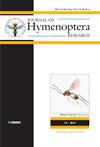Nest characteristics and associates of Dolichovespula (Hymenoptera, Vespidae) in Central Finland
IF 1.4
3区 农林科学
Q2 ENTOMOLOGY
引用次数: 0
Abstract
In social vespine wasps, the nest characteristics and associates vary intra- and interspecifically. I studied the nest characteristics and nest associates of three Dolichovespula wasp species in boreal Finland. The average number of combs and cells per nest was similar among D. media , D. saxonica and D. norwegica , and similar to Dolichovespula in the temperate zone. Most D. media and D. saxonica colonies produced both gynes and males, whereas D. norwegica produced mainly either one. The average colony lifespan of D. saxonica was a bit over two months, i.e. shorter than documented for Dolichovespula in the temperate zone. The proportion of nests parasitised by the ichneumonid wasp Sphecophaga vesparum was 36% in D. saxonica and 50% in D. media ; S. vesparum has not been recorded from D. media before. The proportion of parasitized cells was 0.6–11% for D. saxonica and 0.2–22% for D. media . The proportion yellow, overwintering cocoons of S. vesparum was highly variable among the nests. The proportion of nests parasitised by the moth Aphomia sociella was 36% in D. saxonica and 13% in D. media . Sphecophaga and Aphomia were not recorded from D. norwegica colonies, which supports studies in the temperate zone. The study adds up to the previous research on the nest structure and nest associates of vespines, and together they indicate that there is geographical variation within Europe and globally in the host use of Sphecophaga .Nest芬兰中部小蜂属(膜翅目,小蜂科)的特征及联系
在群居黄蜂中,巢的特征和同伴在种内和种间是不同的。本文研究了芬兰北部三种小黄蜂的巢特征和巢伴。平均蜂巢数和细胞数在中叶锦鸡、撒色锦鸡和挪威锦鸡之间相似,在温带地区也与白斑锦鸡相似。大多数媒介稻和萨克萨克稻的群体同时产生雌性和雄性,而挪威稻则主要产生其中任何一种。saxonica的平均群体寿命为2个多月,比温带的Dolichovespula短。姬蜂寄生巢的比例分别为36%和50%;在此之前,没有在媒介上记录到斑孢霉。红花被寄生细胞比例为0.6 ~ 11%,培养基为0.2 ~ 22%。黄茧和越冬茧的比例在不同的巢中变化很大。社会蚜螨对巢的寄生率分别为36%和13%。在挪威龙舌兰的种群中没有记录到食蚁兽和食蚁兽,这支持了温带地区的研究。这项研究结合了之前对刺巢结构和刺巢相关物的研究,共同表明在欧洲和全球范围内,宿主对Sphecophaga的使用存在地理差异。
本文章由计算机程序翻译,如有差异,请以英文原文为准。
求助全文
约1分钟内获得全文
求助全文
来源期刊
CiteScore
2.60
自引率
15.40%
发文量
68
审稿时长
>12 weeks
期刊介绍:
The Journal of Hymenoptera Research is a peer-reviewed, open-access, rapid online journal launched to accelerate research on all aspects of Hymenoptera, including biology, behavior, ecology, systematics, taxonomy, genetics, and morphology.
All published papers can be freely copied, downloaded, printed and distributed at no charge for the reader. Authors are thus encouraged to post the pdf files of published papers on their homepages or elsewhere to expedite distribution. There is no charge for color.

 求助内容:
求助内容: 应助结果提醒方式:
应助结果提醒方式:


